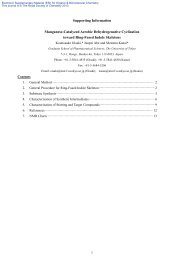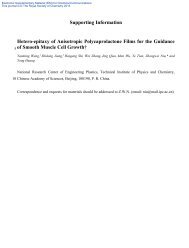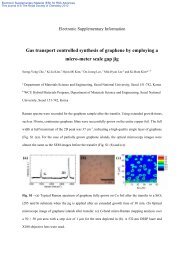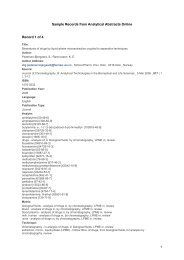Representation of Ethnic Groups in Chemistry and Physics
Representation of Ethnic Groups in Chemistry and Physics
Representation of Ethnic Groups in Chemistry and Physics
Create successful ePaper yourself
Turn your PDF publications into a flip-book with our unique Google optimized e-Paper software.
8: <strong>Ethnic</strong>ity <strong>and</strong> postgraduate studies<br />
8: <strong>Ethnic</strong>ity <strong>and</strong> postgraduate studies<br />
“<strong>Ethnic</strong>-m<strong>in</strong>ority<br />
students<br />
graduat<strong>in</strong>g <strong>in</strong><br />
chemistry <strong>and</strong><br />
physics are more<br />
<strong>in</strong>cl<strong>in</strong>ed to study<br />
subjects other<br />
than chemistry<br />
<strong>and</strong> physics at<br />
postgraduate<br />
level.”<br />
Fig. 25: <strong>Ethnic</strong> <strong>and</strong><br />
gender composition <strong>of</strong><br />
doctorate chemistry.<br />
Notes:<br />
1. The percentages relate to<br />
Engl<strong>and</strong>- <strong>and</strong> Walesdomiciled<br />
students<br />
study<strong>in</strong>g for a doctorate.<br />
2. Numbers exclude those<br />
whose ethnicity is unknown.<br />
Source: HESA student data set<br />
2002/2003<br />
29. The benchmark population is<br />
shown <strong>in</strong> section 6, based on<br />
students complet<strong>in</strong>g their<br />
undergraduate studies <strong>in</strong><br />
2001/2002. The ethnic <strong>and</strong><br />
gender breakdown <strong>of</strong> this group <strong>in</strong><br />
chemistry <strong>and</strong> physics, which is<br />
used for benchmark<br />
comparisons, is shown <strong>in</strong><br />
appendix 8.<br />
percentage <strong>of</strong> all chemistry postgraduates<br />
70<br />
60<br />
50<br />
40<br />
30<br />
20<br />
10<br />
0<br />
59.3<br />
white<br />
0.1 0.2<br />
black Caribbean<br />
black African<br />
2.3<br />
Indian<br />
0.8 0.3 0.8 1.8<br />
Pakistani<br />
male<br />
male<br />
Bangladeshi<br />
female<br />
Ch<strong>in</strong>ese<br />
mixed<br />
The completion <strong>of</strong> undergraduate studies is the f<strong>in</strong>al bifurcation<br />
po<strong>in</strong>t <strong>in</strong> the educational pipel<strong>in</strong>e. At this po<strong>in</strong>t, students<br />
must make decisions regard<strong>in</strong>g their careers <strong>and</strong>, <strong>in</strong><br />
particular, whether or not to study chemistry or physics at<br />
postgraduate level; study <strong>in</strong> an area perhaps more vocationally<br />
orientated; or enter the job market. This section<br />
exam<strong>in</strong>es the extent to which attrition from undergraduate<br />
to postgraduate study depends on ethnicity. This is done<br />
by analys<strong>in</strong>g EGR among postgraduates <strong>in</strong> chemistry <strong>and</strong><br />
physics <strong>in</strong> a similar manner to that previously described.<br />
EGR is measured with reference to a benchmark group <strong>of</strong><br />
those achiev<strong>in</strong>g a first- or upper-second-class degree <strong>in</strong><br />
chemistry or physics. 29<br />
Exam<strong>in</strong><strong>in</strong>g the ethnic composition <strong>of</strong> students study<strong>in</strong>g<br />
for postgraduate qualifications <strong>in</strong> chemistry or physics<br />
based on 2002/2003 student data reveals that, <strong>in</strong> chemistry<br />
<strong>and</strong> physics, the majority <strong>of</strong> students classed as postgraduate<br />
are on doctoral rather than masters programmes.<br />
Based on 2002/2003 figures, 79% <strong>of</strong> postgraduate students<br />
<strong>in</strong> chemistry <strong>and</strong> 76% <strong>of</strong> postgraduate students <strong>in</strong><br />
physics were enrolled on doctorate programmes. Analysis<br />
is therefore restricted to the last stage <strong>of</strong> the pipel<strong>in</strong>e (i.e.<br />
those study<strong>in</strong>g on doctorate programmes).<br />
Figure 25 shows the ethnic <strong>and</strong> gender composition <strong>of</strong><br />
doctorate chemistry, based on a percentage breakdown <strong>of</strong><br />
the student body. White males dom<strong>in</strong>ate the Engl<strong>and</strong>- <strong>and</strong><br />
Wales-domiciled doctorate chemistry student body, <strong>in</strong> contrast<br />
to the less pronounced gender imbalance <strong>in</strong> undergraduate<br />
chemistry, with numbers <strong>of</strong> ethnic-m<strong>in</strong>ority<br />
students be<strong>in</strong>g very small.<br />
To measure EGR the data are normalised (by subject)<br />
with respect to the population that achieves a first or uppersecond,<br />
as described above. The result<strong>in</strong>g measures <strong>of</strong> EGR<br />
are shown <strong>in</strong> figure 26. This confirms white male dom<strong>in</strong>ation.<br />
Us<strong>in</strong>g a chi-squared significance test, it is shown that<br />
students are not r<strong>and</strong>omly allocated to postgraduate chemistry<br />
by ethnic group, based on the population <strong>of</strong> undergraduates<br />
achiev<strong>in</strong>g a first- or upper-second-class degree <strong>in</strong><br />
chemistry.<br />
Data show that white males are over-represented relative<br />
to their undergraduate numbers, whereas white<br />
females <strong>and</strong> most non-white groups, particularly ethnic<br />
Asian students, are notably under-represented.<br />
Similar patterns are observed for physics. Us<strong>in</strong>g a chisquared<br />
significance test, it is shown that students are not<br />
r<strong>and</strong>omly allocated to postgraduate physics by ethnic<br />
group, based on the population <strong>of</strong> undergraduates achiev<strong>in</strong>g<br />
a first or upper-second <strong>in</strong> the same subject. Figure 27<br />
shows the ethnic <strong>and</strong> gender composition <strong>of</strong> the Engl<strong>and</strong><strong>and</strong><br />
Wales-domiciled doctorate physics student body.<br />
Figure 28 shows the EGR for physics relative to numbers<br />
achiev<strong>in</strong>g a first or upper-second at undergraduate level.<br />
The data show that, even relative to the population<br />
achiev<strong>in</strong>g first- or upper-second-class degrees at undergraduate<br />
level, those outside the white male population<br />
(with only m<strong>in</strong>or exceptions) show relatively little <strong>in</strong>cl<strong>in</strong>ation<br />
to study physics beyond undergraduate level.<br />
Further study <strong>in</strong> other subjects<br />
The proportion <strong>of</strong> students go<strong>in</strong>g on to further study <strong>in</strong> general,<br />
not necessarily <strong>in</strong> chemistry or physics, is now exam<strong>in</strong>ed.<br />
Figure 29 shows the percentage <strong>of</strong> chemistry <strong>and</strong><br />
physics graduates, by ethnic group, go<strong>in</strong>g on to further<br />
study (irrespective <strong>of</strong> subject), based onthe HESA first des-<br />
30.4<br />
white<br />
0.1 0.3 1.3 0.7 0.1 0.5 1.1<br />
black Caribbean<br />
black African<br />
Indian<br />
Pakistani<br />
female<br />
Bangladeshi<br />
Ch<strong>in</strong>ese<br />
other/mixed<br />
30 R EPRESENTATION OF E THNIC G ROUPS IN C HEMISTRY AND P HYSICS M AY 2006
















